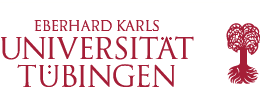Literary History and the Canon
(13 Einträge)
Vorlesung Literary History and the Canon: How Texts Are Read and Understood, 1. und 2. Stunde
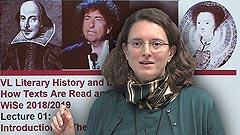

| Title: | Vorlesung Literary History and the Canon: How Texts Are Read and Understood, 1. und 2. Stunde |
| Description: | Vorlesung im WiSe 2018-2019; Dienstag, 23. Oktober 2018 |
| Creator: | Angelika Zirker (author) |
| Contributor: | ZDV Universität Tübingen (producer) |
| Publisher: | ZDV Universität Tübingen |
| Date Created: | 2018-10-23 |
| Subjects: | Englisches Seminar, Literary History, Canon, Lecture, Vorlesung, Contemporary Canon Formation, New Elizabethans, Big Read, |
| Identifier: | UT_20181023_001_lithistcan_0001 |
| Rights: | Rechtshinweise |
| Abstracts: | Quite recently, the TLS (Times Literary Supplement) asked 200 people in the publishing industry - i.e. editors, critics, writers of fiction, academics - to nominate those writers whom they considered to produce the "best writing" in our time (see TLS April 6, 2008: 3). The outcome, a list of the best British and Irish novelists today, was labelled "The New Elizabethans" and has sparked a debate between those who are exited at the sheer amount of great writers in our period and those who fear the creation of an elite, a new canon. In this lecture course, I would like to consider the question of how the literary canon has been formed throughout the history of English literature, and how texts have been understood in particular political, socioeconomic, aesthetic and other contexts. We will discuss the works of William Shakespeare and their reception in the eighteenth century, the rediscovery of metaphysical poetry in the early twentieth century, women writers from the Renaissance as well as later literary periods, and move towards the canonical status of literary adaptation and fan fiction in the twenty-first century. Students will gain an insight into literary history as well as theoretical issues when it comes to reading and understanding literature. |
Vorlesung Literary History and the Canon: How Texts Are Read and Understood, 3. und 4. Stunde
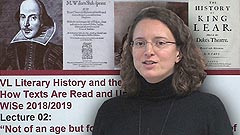

| Title: | Vorlesung Literary History and the Canon: How Texts Are Read and Understood, 3. und 4. Stunde |
| Description: | Vorlesung im WiSe 2018-2019; Dienstag, 30. Oktober 2018 |
| Creator: | Angelika Zirker (author) |
| Contributor: | ZDV Universität Tübingen (producer) |
| Publisher: | ZDV Universität Tübingen |
| Date Created: | 2018-10-30 |
| Subjects: | Englisches Seminar, Literary History, Canon, Lecture, Vorlesung, William Shakespeare, Re-Discovery, 18th Century, King Lear, Nahum Tate, David Garrick, |
| Identifier: | UT_20181030_001_lithistcan_0001 |
| Rights: | Rechtshinweise |
| Abstracts: | Quite recently, the TLS (Times Literary Supplement) asked 200 people in the publishing industry - i.e. editors, critics, writers of fiction, academics - to nominate those writers whom they considered to produce the "best writing" in our time (see TLS April 6, 2008: 3). The outcome, a list of the best British and Irish novelists today, was labelled "The New Elizabethans" and has sparked a debate between those who are exited at the sheer amount of great writers in our period and those who fear the creation of an elite, a new canon. In this lecture course, I would like to consider the question of how the literary canon has been formed throughout the history of English literature, and how texts have been understood in particular political, socioeconomic, aesthetic and other contexts. We will discuss the works of William Shakespeare and their reception in the eighteenth century, the rediscovery of metaphysical poetry in the early twentieth century, women writers from the Renaissance as well as later literary periods, and move towards the canonical status of literary adaptation and fan fiction in the twenty-first century. Students will gain an insight into literary history as well as theoretical issues when it comes to reading and understanding literature. |
Vorlesung Literary History and the Canon: How Texts Are Read and Understood, 5. und 6. Stunde
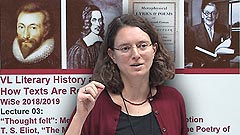

| Title: | Vorlesung Literary History and the Canon: How Texts Are Read and Understood, 5. und 6. Stunde |
| Description: | Vorlesung im WiSe 2018-2019; Dienstag, 06. November 2018 |
| Creator: | Angelika Zirker (author) |
| Contributor: | ZDV Universität Tübingen (producer) |
| Publisher: | ZDV Universität Tübingen |
| Date Created: | 2018-11-06 |
| Subjects: | Englisches Seminar, Literary History, Canon, Lecture, Vorlesung, Thought felt, Metaphysical Poetry, T.S. Eliot, The Metaphysical Poets, John Donne, George Herbert, |
| Identifier: | UT_20181106_001_lithistcan_0001 |
| Rights: | Rechtshinweise |
| Abstracts: | Quite recently, the TLS (Times Literary Supplement) asked 200 people in the publishing industry - i.e. editors, critics, writers of fiction, academics - to nominate those writers whom they considered to produce the "best writing" in our time (see TLS April 6, 2008: 3). The outcome, a list of the best British and Irish novelists today, was labelled "The New Elizabethans" and has sparked a debate between those who are exited at the sheer amount of great writers in our period and those who fear the creation of an elite, a new canon. In this lecture course, I would like to consider the question of how the literary canon has been formed throughout the history of English literature, and how texts have been understood in particular political, socioeconomic, aesthetic and other contexts. We will discuss the works of William Shakespeare and their reception in the eighteenth century, the rediscovery of metaphysical poetry in the early twentieth century, women writers from the Renaissance as well as later literary periods, and move towards the canonical status of literary adaptation and fan fiction in the twenty-first century. Students will gain an insight into literary history as well as theoretical issues when it comes to reading and understanding literature. |
Vorlesung Literary History and the Canon: How Texts Are Read and Understood, 7. und 8. Stunde
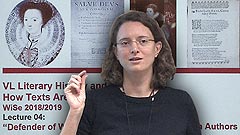

| Title: | Vorlesung Literary History and the Canon: How Texts Are Read and Understood, 7. und 8. Stunde |
| Description: | Vorlesung im WiSe 2018-2019; Dienstag, 13. November 2018 |
| Creator: | Angelika Zirker (author) |
| Contributor: | ZDV Universität Tübingen (producer) |
| Publisher: | ZDV Universität Tübingen |
| Date Created: | 2018-11-13 |
| Subjects: | Englisches Seminar, Literary History, Canon, Lecture, Vorlesung, Defender of Womankind, Renaissance Women Authors, Aemilia Lanyer, Salve Deus Rex Judaeorum, The Description of Cooke-ham, |
| Identifier: | UT_20181113_001_lithistcan_0001 |
| Rights: | Rechtshinweise |
| Abstracts: | Quite recently, the TLS (Times Literary Supplement) asked 200 people in the publishing industry - i.e. editors, critics, writers of fiction, academics - to nominate those writers whom they considered to produce the "best writing" in our time (see TLS April 6, 2008: 3). The outcome, a list of the best British and Irish novelists today, was labelled "The New Elizabethans" and has sparked a debate between those who are exited at the sheer amount of great writers in our period and those who fear the creation of an elite, a new canon. In this lecture course, I would like to consider the question of how the literary canon has been formed throughout the history of English literature, and how texts have been understood in particular political, socioeconomic, aesthetic and other contexts. We will discuss the works of William Shakespeare and their reception in the eighteenth century, the rediscovery of metaphysical poetry in the early twentieth century, women writers from the Renaissance as well as later literary periods, and move towards the canonical status of literary adaptation and fan fiction in the twenty-first century. Students will gain an insight into literary history as well as theoretical issues when it comes to reading and understanding literature. |
Vorlesung Literary History and the Canon: How Texts Are Read and Understood, 9. und 10. Stunde
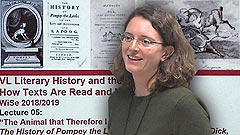

| Title: | Vorlesung Literary History and the Canon: How Texts Are Read and Understood, 9. und 10. Stunde |
| Description: | Vorlesung im WiSe 2018-2019; Dienstag, 20. November 2018 |
| Creator: | Angelika Zirker (author) |
| Contributor: | ZDV Universität Tübingen (producer) |
| Publisher: | ZDV Universität Tübingen |
| Date Created: | 2018-11-20 |
| Subjects: | Englisches Seminar, Literary History, Canon, Lecture, Vorlesung, Animal Studies, The History of Pompey the Little, Francis Coventry, Memoirs of Dick, the Little Poney, |
| Identifier: | UT_20181120_001_lithistcan_0001 |
| Rights: | Rechtshinweise |
| Abstracts: | Quite recently, the TLS (Times Literary Supplement) asked 200 people in the publishing industry - i.e. editors, critics, writers of fiction, academics - to nominate those writers whom they considered to produce the "best writing" in our time (see TLS April 6, 2008: 3). The outcome, a list of the best British and Irish novelists today, was labelled "The New Elizabethans" and has sparked a debate between those who are exited at the sheer amount of great writers in our period and those who fear the creation of an elite, a new canon. In this lecture course, I would like to consider the question of how the literary canon has been formed throughout the history of English literature, and how texts have been understood in particular political, socioeconomic, aesthetic and other contexts. We will discuss the works of William Shakespeare and their reception in the eighteenth century, the rediscovery of metaphysical poetry in the early twentieth century, women writers from the Renaissance as well as later literary periods, and move towards the canonical status of literary adaptation and fan fiction in the twenty-first century. Students will gain an insight into literary history as well as theoretical issues when it comes to reading and understanding literature. |
Vorlesung Literary History and the Canon: How Texts Are Read and Understood, 11. und 12. Stunde
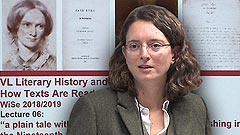

| Title: | Vorlesung Literary History and the Canon: How Texts Are Read and Understood, 11. und 12. Stunde |
| Description: | Vorlesung im WiSe 2018-2019; Dienstag, 27. November 2018 |
| Creator: | Angelika Zirker (author) |
| Contributor: | ZDV Universität Tübingen (producer) |
| Publisher: | ZDV Universität Tübingen |
| Date Created: | 2018-11-27 |
| Subjects: | Englisches Seminar, Literary History, Canon, Lecture, Vorlesung, Women Publishing, Nineteenth Century, Charlotte Brontë, Jane Eyre, George Henry Lewes, |
| Identifier: | UT_20181127_001_lithistcan_0001 |
| Rights: | Rechtshinweise |
| Abstracts: | Quite recently, the TLS (Times Literary Supplement) asked 200 people in the publishing industry - i.e. editors, critics, writers of fiction, academics - to nominate those writers whom they considered to produce the "best writing" in our time (see TLS April 6, 2008: 3). The outcome, a list of the best British and Irish novelists today, was labelled "The New Elizabethans" and has sparked a debate between those who are exited at the sheer amount of great writers in our period and those who fear the creation of an elite, a new canon. In this lecture course, I would like to consider the question of how the literary canon has been formed throughout the history of English literature, and how texts have been understood in particular political, socioeconomic, aesthetic and other contexts. We will discuss the works of William Shakespeare and their reception in the eighteenth century, the rediscovery of metaphysical poetry in the early twentieth century, women writers from the Renaissance as well as later literary periods, and move towards the canonical status of literary adaptation and fan fiction in the twenty-first century. Students will gain an insight into literary history as well as theoretical issues when it comes to reading and understanding literature. |
Vorlesung Literary History and the Canon: How Texts Are Read and Understood, 13. und 14. Stunde
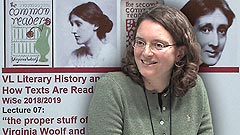

| Title: | Vorlesung Literary History and the Canon: How Texts Are Read and Understood, 13. und 14. Stunde |
| Description: | Vorlesung im WiSe 2018-2019; Dienstag, 04. Dezember 2018 |
| Creator: | Angelika Zirker (author) |
| Contributor: | ZDV Universität Tübingen (producer) |
| Publisher: | ZDV Universität Tübingen |
| Date Created: | 2018-12-04 |
| Subjects: | Englisches Seminar, Literary History, Canon, Lecture, Vorlesung, Virginia Woolf, The Common Reader, Modern Fiction, Read a Book, |
| Identifier: | UT_20181204_001_lithistcan_0001 |
| Rights: | Rechtshinweise |
| Abstracts: | Quite recently, the TLS (Times Literary Supplement) asked 200 people in the publishing industry - i.e. editors, critics, writers of fiction, academics - to nominate those writers whom they considered to produce the "best writing" in our time (see TLS April 6, 2008: 3). The outcome, a list of the best British and Irish novelists today, was labelled "The New Elizabethans" and has sparked a debate between those who are exited at the sheer amount of great writers in our period and those who fear the creation of an elite, a new canon. In this lecture course, I would like to consider the question of how the literary canon has been formed throughout the history of English literature, and how texts have been understood in particular political, socioeconomic, aesthetic and other contexts. We will discuss the works of William Shakespeare and their reception in the eighteenth century, the rediscovery of metaphysical poetry in the early twentieth century, women writers from the Renaissance as well as later literary periods, and move towards the canonical status of literary adaptation and fan fiction in the twenty-first century. Students will gain an insight into literary history as well as theoretical issues when it comes to reading and understanding literature. |
Vorlesung Literary History and the Canon: How Texts Are Read and Understood, 15. und 16. Stunde
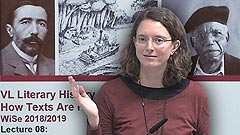

| Title: | Vorlesung Literary History and the Canon: How Texts Are Read and Understood, 15. und 16. Stunde |
| Description: | Vorlesung im WiSe 2018-2019; Dienstag, 11. Dezember 2018 |
| Creator: | Angelika Zirker (author) |
| Contributor: | ZDV Universität Tübingen (producer) |
| Publisher: | ZDV Universität Tübingen |
| Date Created: | 2018-12-11 |
| Subjects: | Englisches Seminar, Literary History, Canon, Lecture, Vorlesung, bloody racis(m), Postcolonial Readers, Joseph Conrad, Heart of Darkness, Contemporary Reviews, Chinua Achebe, |
| Identifier: | UT_20181211_001_lithistcan_0001 |
| Rights: | Rechtshinweise |
| Abstracts: | Quite recently, the TLS (Times Literary Supplement) asked 200 people in the publishing industry - i.e. editors, critics, writers of fiction, academics - to nominate those writers whom they considered to produce the "best writing" in our time (see TLS April 6, 2008: 3). The outcome, a list of the best British and Irish novelists today, was labelled "The New Elizabethans" and has sparked a debate between those who are exited at the sheer amount of great writers in our period and those who fear the creation of an elite, a new canon. In this lecture course, I would like to consider the question of how the literary canon has been formed throughout the history of English literature, and how texts have been understood in particular political, socioeconomic, aesthetic and other contexts. We will discuss the works of William Shakespeare and their reception in the eighteenth century, the rediscovery of metaphysical poetry in the early twentieth century, women writers from the Renaissance as well as later literary periods, and move towards the canonical status of literary adaptation and fan fiction in the twenty-first century. Students will gain an insight into literary history as well as theoretical issues when it comes to reading and understanding literature. |
Vorlesung Literary History and the Canon: How Texts Are Read and Understood, 17. und 18. Stunde
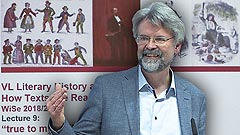

| Title: | Vorlesung Literary History and the Canon: How Texts Are Read and Understood, 17. und 18. Stunde |
| Description: | Vorlesung im WiSe 2018-2019; Dienstag, 18. Dezember 2018 |
| Creator: | Angelika Zirker (author), Matthias Bauer (author) |
| Contributor: | ZDV Universität Tübingen (producer) |
| Publisher: | ZDV Universität Tübingen |
| Date Created: | 2018-12-18 |
| Subjects: | Englisches Seminar, Literary History, Canon, Lecture, Vorlesung, Charles Dickens, Railway Accident, Public Reading, Canonization, Sikes and Nancy, Monopolylogue, Identification, |
| Identifier: | UT_20181218_001_lithistcan_0001 |
| Rights: | Rechtshinweise |
| Abstracts: | Quite recently, the TLS (Times Literary Supplement) asked 200 people in the publishing industry - i.e. editors, critics, writers of fiction, academics - to nominate those writers whom they considered to produce the "best writing" in our time (see TLS April 6, 2008: 3). The outcome, a list of the best British and Irish novelists today, was labelled "The New Elizabethans" and has sparked a debate between those who are exited at the sheer amount of great writers in our period and those who fear the creation of an elite, a new canon. In this lecture course, I would like to consider the question of how the literary canon has been formed throughout the history of English literature, and how texts have been understood in particular political, socioeconomic, aesthetic and other contexts. We will discuss the works of William Shakespeare and their reception in the eighteenth century, the rediscovery of metaphysical poetry in the early twentieth century, women writers from the Renaissance as well as later literary periods, and move towards the canonical status of literary adaptation and fan fiction in the twenty-first century. Students will gain an insight into literary history as well as theoretical issues when it comes to reading and understanding literature. |
Vorlesung Literary History and the Canon: How Texts Are Read and Understood, 19. und 20. Stunde
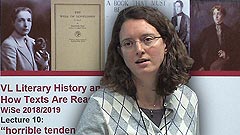

| Title: | Vorlesung Literary History and the Canon: How Texts Are Read and Understood, 19. und 20. Stunde |
| Description: | Vorlesung im WiSe 2018-2019; Dienstag, 08. Januar 2019 |
| Creator: | Angelika Zirker (author) |
| Contributor: | ZDV Universität Tübingen (producer) |
| Publisher: | ZDV Universität Tübingen |
| Date Created: | 2019-01-08 |
| Subjects: | Englisches Seminar, Literary History, Canon, Lecture, Vorlesung, Queer Writing, Radclyffe Hall, The Well of Loneliness, Inversion, |
| Identifier: | UT_20190108_001_lithistcan_0001 |
| Rights: | Rechtshinweise |
| Abstracts: | Quite recently, the TLS (Times Literary Supplement) asked 200 people in the publishing industry - i.e. editors, critics, writers of fiction, academics - to nominate those writers whom they considered to produce the "best writing" in our time (see TLS April 6, 2008: 3). The outcome, a list of the best British and Irish novelists today, was labelled "The New Elizabethans" and has sparked a debate between those who are exited at the sheer amount of great writers in our period and those who fear the creation of an elite, a new canon. In this lecture course, I would like to consider the question of how the literary canon has been formed throughout the history of English literature, and how texts have been understood in particular political, socioeconomic, aesthetic and other contexts. We will discuss the works of William Shakespeare and their reception in the eighteenth century, the rediscovery of metaphysical poetry in the early twentieth century, women writers from the Renaissance as well as later literary periods, and move towards the canonical status of literary adaptation and fan fiction in the twenty-first century. Students will gain an insight into literary history as well as theoretical issues when it comes to reading and understanding literature. |
Vorlesung Literary History and the Canon: How Texts Are Read and Understood, 21. und 22. Stunde
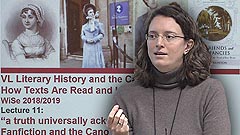

| Title: | Vorlesung Literary History and the Canon: How Texts Are Read and Understood, 21. und 22. Stunde |
| Description: | Vorlesung im WiSe 2018-2019; Dienstag, 15. Januar 2019 |
| Creator: | Angelika Zirker (author) |
| Contributor: | ZDV Universität Tübingen (producer) |
| Publisher: | ZDV Universität Tübingen |
| Date Created: | 2019-01-15 |
| Subjects: | Englisches Seminar, Literary History, Canon, Lecture, Vorlesung, Jane Austen, Pride and Prejudice, Fanfiction, Sequels, Rewritings, Sybil G. Brinton, Stylistic Imitation, |
| Identifier: | UT_20190115_001_lithistcan_0001 |
| Rights: | Rechtshinweise |
| Abstracts: | Quite recently, the TLS (Times Literary Supplement) asked 200 people in the publishing industry - i.e. editors, critics, writers of fiction, academics - to nominate those writers whom they considered to produce the "best writing" in our time (see TLS April 6, 2008: 3). The outcome, a list of the best British and Irish novelists today, was labelled "The New Elizabethans" and has sparked a debate between those who are exited at the sheer amount of great writers in our period and those who fear the creation of an elite, a new canon. In this lecture course, I would like to consider the question of how the literary canon has been formed throughout the history of English literature, and how texts have been understood in particular political, socioeconomic, aesthetic and other contexts. We will discuss the works of William Shakespeare and their reception in the eighteenth century, the rediscovery of metaphysical poetry in the early twentieth century, women writers from the Renaissance as well as later literary periods, and move towards the canonical status of literary adaptation and fan fiction in the twenty-first century. Students will gain an insight into literary history as well as theoretical issues when it comes to reading and understanding literature. |
Vorlesung Literary History and the Canon: How Texts Are Read and Understood, 23. und 24. Stunde
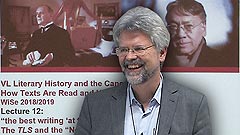

| Title: | Vorlesung Literary History and the Canon: How Texts Are Read and Understood, 23. und 24. Stunde |
| Description: | Vorlesung im WiSe 2018-2019; Dienstag, 22. Januar 2019 |
| Creator: | Angelika Zirker (author), Matthias Bauer (author) |
| Contributor: | ZDV Universität Tübingen (producer) |
| Publisher: | ZDV Universität Tübingen |
| Date Created: | 2019-01-22 |
| Subjects: | Englisches Seminar, Literary History, Canon, Lecture, Vorlesung, Kazuo Ishiguro, The Remains of the Day, Times Literary Supplement (TLS), New Elizabethans, Canonization, Narrative Style, Service, Professionalism, Greatness, Nature of Dignity, |
| Identifier: | UT_20190122_001_lithistcan_0001 |
| Rights: | Rechtshinweise |
| Abstracts: | Quite recently, the TLS (Times Literary Supplement) asked 200 people in the publishing industry - i.e. editors, critics, writers of fiction, academics - to nominate those writers whom they considered to produce the "best writing" in our time (see TLS April 6, 2008: 3). The outcome, a list of the best British and Irish novelists today, was labelled "The New Elizabethans" and has sparked a debate between those who are exited at the sheer amount of great writers in our period and those who fear the creation of an elite, a new canon. In this lecture course, I would like to consider the question of how the literary canon has been formed throughout the history of English literature, and how texts have been understood in particular political, socioeconomic, aesthetic and other contexts. We will discuss the works of William Shakespeare and their reception in the eighteenth century, the rediscovery of metaphysical poetry in the early twentieth century, women writers from the Renaissance as well as later literary periods, and move towards the canonical status of literary adaptation and fan fiction in the twenty-first century. Students will gain an insight into literary history as well as theoretical issues when it comes to reading and understanding literature. |
Vorlesung Literary History and the Canon: How Texts Are Read and Understood, 25. und 26. Stunde
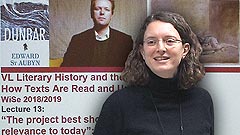

| Title: | Vorlesung Literary History and the Canon: How Texts Are Read and Understood, 25. und 26. Stunde |
| Description: | Vorlesung im WiSe 2018-2019; Dienstag, 29. Januar 2019 |
| Creator: | Angelika Zirker (author) |
| Contributor: | ZDV Universität Tübingen (producer) |
| Publisher: | ZDV Universität Tübingen |
| Date Created: | 2019-01-29 |
| Subjects: | Englisches Seminar, Literary History, Canon, Lecture, Vorlesung, The Hogarth Shakespeare, Edward St Aubyn, Dunbar, King Lear, |
| Identifier: | UT_20190129_001_lithistcan_0001 |
| Rights: | Rechtshinweise |
| Abstracts: | Quite recently, the TLS (Times Literary Supplement) asked 200 people in the publishing industry - i.e. editors, critics, writers of fiction, academics - to nominate those writers whom they considered to produce the "best writing" in our time (see TLS April 6, 2008: 3). The outcome, a list of the best British and Irish novelists today, was labelled "The New Elizabethans" and has sparked a debate between those who are exited at the sheer amount of great writers in our period and those who fear the creation of an elite, a new canon. In this lecture course, I would like to consider the question of how the literary canon has been formed throughout the history of English literature, and how texts have been understood in particular political, socioeconomic, aesthetic and other contexts. We will discuss the works of William Shakespeare and their reception in the eighteenth century, the rediscovery of metaphysical poetry in the early twentieth century, women writers from the Renaissance as well as later literary periods, and move towards the canonical status of literary adaptation and fan fiction in the twenty-first century. Students will gain an insight into literary history as well as theoretical issues when it comes to reading and understanding literature. |
